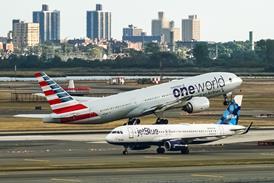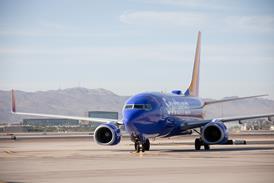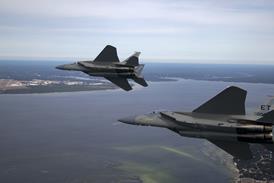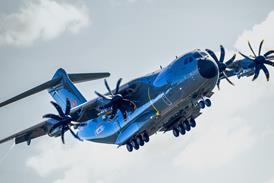Reduced frequencies, suspended services, deferred aircraft deliveries, postponed plans: carriers struggle against devaluation and taxes
This year has been one of the worst for Brazil's airline industry. Flag carrier Varig's announcement that it had posted a 509.1 million Real ($199 million) loss for the first half of 2001 clearly demonstrated this.
More than merely representing one company's 1,950% increase in losses over 2000's first half, Varig's predicament mirrors problems that afflict the industry as a whole. Reducing frequencies, suspending services to assorted destinations, deferring aircraft deliveries and postponing plans have all lately been the norm among Brazil's carriers.
Some numbers belie the Brazilian industry's difficulties. From January to July this year, the airlines flew 28.55 billion revenue passenger kilometres (RPK) - a 500 million increase from the same period last year. Whereas industry RPK values dipped 5.5% on international routes during this year's first half, domestic routes registered a 10% RPK increase. But despite transporting more passengers than it did last year, Brazil's airlines are now operating at a loss - or very nearly so.
One factor contributing to the poor financial performance has been the abrupt devaluation of the Brazilian Real. In Brazil, 35-40% of a carrier's expenses are incurred in US dollars, mainly through aircraft lease installments, fuel bills and spares acquisition. Fuel prices alone, which are indexed to the dollar, have risen nearly 80% over the past 12 months. Nearly R300 million ($117 million) of Varig's mammoth first half loss is attributed to the foreign exchange imbalance.
Regional carrier Nordeste Linhas Aéreas was less hard hit than Varig, but the airline's commercial director Alexandre Camargo, says that the first-half results also could have been "far better. Fuel prices and the US dollar played a decisive role in our financial performance".
Pegged at 1.94 to the US dollar during the first week of January, the Real has since plunged 30% amid growing fears over the economic stability of neighbouring Argentina and Brazil's delicate financial position. With revenue generated mostly in Reals, the airlines have scrambled to offset the unexpected 30% exchange rate deficit. The rising dollar has also hit some carriers where it hurts most - by inhibiting passenger demand on airlines that serve international destinations. In July 2000, a period of the year when affluent Brazilians travel abroad, the industry achieved a 78% load factor. Despite the fact that one fewer local carrier - Vasp - no longer flies to foreign destinations, that number dropped to 72% this July.
Taxation on air transport services is another burden. It is estimated that 34.8% of any airline's revenue is swallowed up by a mind-boggling array of government duties. According to George Ermakoff, president of Brazil's Sindicato Nacional de Empresas Aeroviárias - the national airline association - Brazilian airlines labour under "a completely lop-sided tax burden when compared with that of other countries. Nobody really knows how to calculate it accurately since we have surtaxes imposed upon supplier-furnished services for which taxes have already been levied".
By eroding profit margins, this surfeit of taxes also imposes a problem for carriers that fly international routes. Unencumbered by such heavy taxation, European and US airlines serving Brazilian destinations can offer significantly lower fares than their Brazilian counterparts. As a result, passengers that would otherwise select local carriers to fly abroad opt for overseas carriers. Blunting any competitive edge that they might enjoy over foreigners, this year Brazilian companies were weighed down even more by a new 15% tax levied on disbursals made abroad.
After announcing his airline's first-half losses, Varig chief executive Ozires Silva commented that Brazil had too many carriers. Analysing the state of the market, he said: "The elimination of companies is absolutely normal. Nature does that."
He may well be right. Enduring a rocky ride these past 10 years, Transbrasil may now have suffered a permanent reversal of fortunes - at least as a major carrier. Possessing only four aircraft of its own, the São Paulo-based airline has progressively returned leased aircraft since last April as a result of the US dollar problem.
Shrinking to almost half what it was earlier this year, the carrier now holds seven Boeing 737-300s and three Boeing 767-200s. With two airliners awaiting spares, the company has concentrated on renegotiating its R800 million debt with government agencies and lessors. That has not been made easy by the posting of a R30 million loss for the second quarter and facing an attempt by lessor General Electric Capital Air Services to declare Transbrasil bankrupt.
Further difficulties
Reportedly initiating tentative negotiations to sell 40% of its stock to the US carrier Continental Airlines, it faced further difficulties in August. With suppliers accepting only hard cash to refuel or provide catering services for its aircraft on a day-to-day basis, the airline has been cutting expenses as much as possible.
Nevertheless, the esprit de corps instilled by Transbrasil's founder, the late Omar Fontana, has been evident in recent weeks. Unable to stock the aircraft with meals, the crew of a Fortaleza-São Paulo flight pooled their resources to buy 140 hamburgers for passengers at a fast food chain. In the same vein, Transbrasil flight and cabin crews recently accepted a wage-cut proposal.
Cornered, the company announced restructuring plans that foresee dismissing 30% of its 2,888-strong workforce, performing a sales-leaseback deal for its three Boeing 767-200s and moving its operations from Guarulhos Airport to nearby Congonhas. According to Transbrasil, these measures alone will entail a 35% cut in operational expenses and generate within two months a marginal - but welcome - profit.
São Paulo-based Vasp spent most of 2000 putting its finances in order, opting to return as many aircraft as possible to lessors and rationalising its assets. To an extent, it has been successful. With only four leased 737-300s in its 32-aircraft fleet, first quarter operational expenses were down 42% in relation to the same period last year. While it did endure R75.6 million net losses during the first quarter of 2001, the figure was 65% below that posted in 2000. Maintaining an average 60% load factor during the first half of 2001, Vasp has managed to keep its market share. Company sources say Vasp intends to consolidate its position in the market over the next two or three years before launching any plans to regain lost ground.
Reeling under the load of disbursements on leasing contracts for all but six of its 94-aircraft fleet, Varig posted a record-breaking loss for the first half of 2001. With its global debt assessed at $1.3 billion and climbing, the rising US dollar accounts for nearly R300 million of its losses. Coupled with R170 million in debt interest payments and the rest related to operational expenses, at no other time in its 75-year history has Varig been in such dire straits.
"We were expecting an exceptionally good year," said Varig's CEO when announcing the airline's exceptionally bad financial performance during the first half of 2001. Most certainly the unfavourable dollar/Real exchange rate and rising fuel prices played a role. But, Silva says, "the economic slowdown took us completely by surprise. An aircraft is not something that you just place on a shelf when things go wrong." Analysts indicate that part of Varig's problems can be traced further back than current difficulties. Penalised by a five-year fare freeze that ended in 1990 and also affected rivals Vasp and Transbrasil, Varig's has expanded capital funds as it attempted to work its way between monthly double-digit inflation figures and yearly fare hikes. To compound matters, Varig's unwieldy corporate structure has not allowed it the flexibility to address pressing economic issues.
Varig recognises that it urgently needs to find solutions. As a means of quickly injecting funds into the ailing company, the Ruben Berta Foundation - which controls 87% of the stock of Varig's owner Fundacao Ruben Berta Participacoes (FRBPar) and its four airlines - intends to sell 35% of its voting shares. Likewise, priority will be given to enlisting foreign partners for its VarigLog air cargo company and the recently established VarigVEM aircraft maintenance enterprise.
Despite its financial results, Varig has not cancelled or postponed aircraft ordered as part of its fleet renewal strategy. Indeed, this month will bring the arrival of the first of 14 Boeing 737-800s. To bolster VarigLog's operations, two more cargo-configured Boeing 727-200s are set for delivery in late September. Finally, the first of two confirmed Boeing 777-200s is to be handed over in November.
Born as regional carriers and faring better than their larger FRBPar stablemate Varig, Rio-Sul and Nordeste Linhas Aéreas also logged losses this year, albeit smaller in scale. Both are confident that by aggressively cutting costs they can overturn the negative financial results. Most measures taken have been orthodox in nature, but Salvador-based Nordeste Linhas Aéreas has shown that the unorthodox will work equally well. It has cut 50% of the leasing expenses on one of its four Boeing 737-500s by using it as a billboard through an advertisement contract with Brazil's leading financial newspaper. Two further contracts are ready to be signed.
Newcomer Gol Transportes Aéreos, Brazil's first low-fare airline, has, not unexpectedly, fared better than most. Company sources have stated that it has operated at a slight profit since July. Transporting more than one million passengers since it started operations last January, Gol has aggressively sought to wrest a larger share of the market, which now rests at 5.12%. Registering in July a load factor of 78%, according to Brazil's civil aviation authorities, the carrier intends to end the year with a 9% market share or better when it will have all 10 of the initially ordered Boeing 737-700s. Planning to receive a further four aircraft next year, it recently launched a system of internet fare auctions it hopes will increase load factors significantly on selected routes. Next month, Gol will add another three destinations to the 10 on its route network. Gol's enviable financial track record is basically ascribed to the carrier's diligent attention to maintaining a tight and trim operation - in contrast to the country's other carriers.
While it did suffer a R99 million net loss during this year's first quarter, TAM Linhas Aéreas was quick to react to the adverse affects of the rising dollar, spiralling fuel prices and the cooling of the country's economy. Delaying plans to launch its São Paulo-Madrid service in 2002, TAM also postponed a $20 million scheme to improve information services.
According to commercial and marketing vice-president Luiz Eduardo Falco, the crisis did dent TAM's profitability, but the airline has not been overly handicapped. Indeed, it has maintained a growth rate consistent with its overall strategy. So far unaffected by the death of founding chief executive Rolim Amaro, TAM recently overtook Varig in the domestic market. Gearing itself to grab a larger slice of the international routes market, TAM has scheduled the launch of services to New York and another, as-yet unannounced, US destination while increasing frequencies over many of its international routes. Should its measures work, the company forecasts a gross income of R2.9 billion - measurably better than last year's results.
Fare relief
Operating for nearly 50 years in a highly regulated airfare environment, Brazilian carriers have been relieved by the government's relaxation of its rein on fares since last year. Moves toward deregulation culminated on 14 August in a government edict that withdrew all restrictions on airfare pricing. Local carriers will be able to operate under market laws, with all the flexibility it entails.
Although no measures can be taken to neutralise the increase in fuel prices and the upward climb of the US dollar, the Brazilian Government has signalled its intention to help its air transport industry - not through the injection of public funds, but by substantially reducing the tax burden. Government and airline executives convened in late August to hammer out an emergency plan that industry sources believe will lead to considerable change in legislation - most critically reducing the 34.8% duty load to 15-20%.
Source: Flight International























